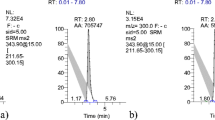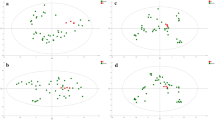Summary
To study the relationship between the late postmortem interval (PMI) and trimethylamine-nitrogen (TMA-N) in postmortem tissues of cadaver, TMA-N in muscles, livers and kidneys of rats was measured at different postmortem intervals (PMI) by using a modified spectrophotometric method. The results indicated that the detection sensitivity of TMA-N was 1 mg/L, and there was a good linear correlation between the value of absorbance (A value) and TMA-N at the concentration of 1–10 mg/L (R 2 = 0.9991). Although TMA variation in muscles was different from that in inner organs during the time since death, TMA-N changes in cadaver tissues was positively correlated with PMI. During 2 to 7 d since death, the best correlation between PMI and TMA-N concentration was found in muscles. With PMI as an independent variable, the cubic polynomial regression equation was y= −0.457x3+6.519x2−24.574x+27.207 (R 2=0.969). During 3 to 8 days since death, PMI was best correlated with TMA-N concentration in inner organs. With PMI as the independent variable, the cubic polynomial regression equation was y=0.509x3−9.153x2+55.727x−95.819 (R 2=0.953). It was concluded that TMA-N in tissues could be used as a new estimator for late PMI. The method used in this study offered advantages such as accuracy, sensitivity, little samples required and wide PMI estimation.
Similar content being viewed by others
References
Henssge C, Madea B. Estimation of the time since death in the early post-mortem period. Forensic Sci Int, 2004,144(2–3):167–175
Wolrat H, Ståhlbom B, Hallen A et al. Trimethylamine and trimethylamine oxide levels in normal women and women with bacterial vaginosis reflect a local metabolism in vaginal secretion as compared to urine. APMIS, 2005,113:513–516
Barrett E L, Kwan H S. Bacterial reduction of trimethylamine oxide. Annu Rev Microbiol, 1985(39):131–149
Wong K, Gill T A. Enzymatic determination of trimethylamine and its relationship to fish quality. J Food Sci, 1987,52(6):1–3
Li X M, Zhong A G. Detection of Trimethyl amine in ambient air by gas chromatography. Chin J Spectrosc Lab (Chinese), 2006,23(2):353–355
Dyer W J. Amines in fish muscle. I. Colorimetric determination of trimethylamine as the picrate salt. J Fish Res Board Can, 1945,6:351–358
State Standard of the People’s Republic of China. Determination of Trimethylamine Nitrogen in Ham. GB/T 5009.179-2003
Xu L F, Yu F L, Hu Z Y et al. Amendment of Method for Determination of Trimethylamine Nitrogen in Ham. Prey Med Trib, 2005,11(6):641–643
Hao L G, Deng S X, Zhao X C. Recent advancement in relationship between DNA degradation and postmortem interval. Fa Yi Xue Za Zhi (Chinese), 2007,23(2):145–147
Finehout E J, Franck Z, Relkin N et al. Proteomic analysis of cerebrospinal fluid changes related to postmortem interval. Clin Chem, 2006,52(10):1906–1913
Singh D, Prashad R, Sharma S K. Estimation of postmortem interval from human pericardial fluid electrolytes concentrations in Chandigarh zone of India: log transformed linear regression model. Leg Med (Tokyo), 2006,8(5):279–287
Gong Z Q, Zeng X B, Sun Y G et al. Study on the relationship between PMI and the concentration of 21 elements in vitreous humor of rabbit after death. Fa Yi Xue Za Zhi (Chinese), 2005,18(2):67–69
Luo G H, Chen Y C, Cheng J D et al. Relationship between DNA degradation and postmortem interval of corrupt corpse. Fa Yi Xue Za Zhi (Chinese), 2006,22(1):7–9
Henssge C, Knight B, Krompecher T et al. The estimation of the time since death in the early postmortem period. London: Edward Arnold, 1995.106–137
Bocaz-Beneventi G, Tagliaro F, Bortolotti F et al. Capillary zone electrophoresis and artificial neural networks for estimation of the post-mortem interval (PMI) using electrolytes measurements in human vitreous humour. Int J Legal Med, 2002,116(1):5–11
Author information
Authors and Affiliations
Additional information
Qian LIU, female, born in 1980, Doctorial Candidate
This project was supported by a grant from the Health Department of Hubei Province (No. JX2B02).
Rights and permissions
About this article
Cite this article
Liu, Q., Cai, X., Liu, Y. et al. Spectrophotometric determination of trimethylamine-nitrogen in cadaver tissues for the estimation of late postmortem interval: A pilot study. J. Huazhong Univ. Sci. Technol. [Med. Sci.] 28, 630–633 (2008). https://doi.org/10.1007/s11596-008-0603-x
Received:
Published:
Issue Date:
DOI: https://doi.org/10.1007/s11596-008-0603-x




